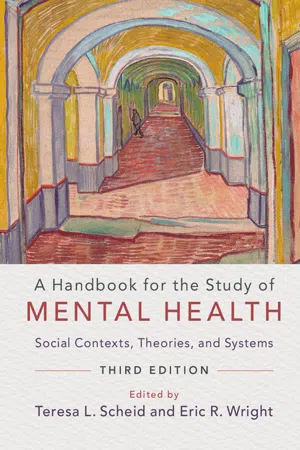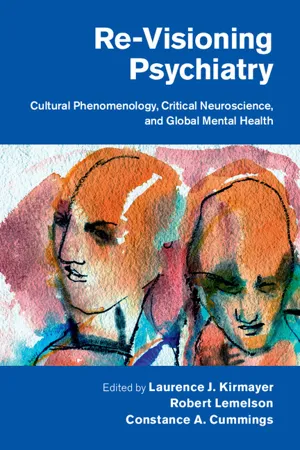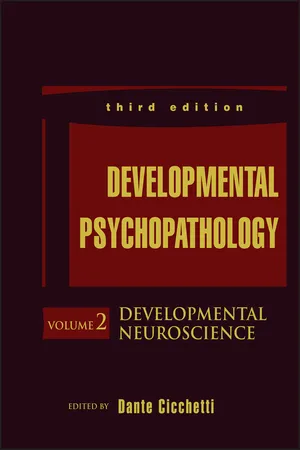Psychology
Psychological Perspectives and Etiology of Disorders
Psychological perspectives on the etiology of disorders refer to the various theoretical frameworks used to understand the origins and development of mental health conditions. These perspectives include biological, psychodynamic, behavioral, cognitive, and sociocultural approaches, each offering unique insights into the causes of psychological disorders. By examining these perspectives, psychologists can gain a comprehensive understanding of the complex interplay of factors contributing to mental health issues.
Written by Perlego with AI-assistance
Related key terms
1 of 5
10 Key excerpts on "Psychological Perspectives and Etiology of Disorders"
- eBook - PDF
- Rose M. Spielman, William J. Jenkins, Marilyn D. Lovett(Authors)
- 2020(Publication Date)
- Openstax(Publisher)
Each of us experiences episodes of sadness, anxiety, and preoccupation with certain thoughts—times when we do not quite feel ourselves. These episodes should not be considered problematic unless the accompanying thoughts and behaviors become extreme and have a disruptive effect on one’s life. Second, understand that people with psychological disorders are far more than just embodiments of their disorders. We do not use terms such as schizophrenics, depressives, or phobics because they are labels that objectify people who have these conditions, thus promoting biased and disparaging assumptions about them. It is important to remember that a psychological disorder is not what a person is; it is something that a person has—through no fault of their own. As is the case with cancer or diabetes, those with psychological disorders suffer debilitating, often painful conditions that are not of their own choosing. These individuals deserve to be viewed and treated with compassion, understanding, and dignity. 15.3 Perspectives on Psychological Disorders LEARNING OBJECTIVES By the end of this section, you will be able to: • Discuss supernatural perspectives on the origin of psychological disorders, in their historical context • Describe modern biological and psychological perspectives on the origin of psychological disorders • Identify which disorders generally show the highest degree of heritability • Describe the diathesis-stress model and its importance to the study of psychopathology Scientists, mental health professionals, and cultural healers may adopt different perspectives in attempting to understand or explain the underlying mechanisms that contribute to the development of a psychological disorder. The specific perspective used in explaining a psychological disorder is extremely important. Each perspective explains psychological disorders, their causes or etiology, and effective treatments from a different viewpoint. - eBook - ePub
Understanding Psychology for Medicine and Nursing
Insights and Applications
- Mohamed Ahmed Abd El-Hay(Author)
- 2019(Publication Date)
- Routledge(Publisher)
The classification is called diagnosis, and the methods used to try to change the behavior are called therapies. If the deviant behavior ceases, the patient is described as cured. This way of talking about psychological abnormality reflects the medical model of thinking, where abnormal behavior is seen as indicative of an underlying illness. However, when we label people as sick or ill, we are removing from them all responsibility for their behavior, just as we do not normally hold someone responsible for having the common cold. Conclusion: because of difficulties defining a specific set of behaviors that everyone, everywhere, will agree to consider as abnormality, and as no single criterion or perspective is entirely adequate in identifying abnormality, it is appropriate to combine aspects of different perspectives. Thus, the person’s behavior, emotional reaction, and the consequences of the behavior of that person are to be considered within the sociocultural context of the person. The effect of age, gender, and culture, as well as the effect of a particular situation and the historical era in which people live should be considered to define what is appropriate when defining the words “appropriate,” “expected,” and “functional” behavior. Etiology of Psychiatric Disorders Attempts to understand the etiology of psychiatric disorders generally fall under one of the three broad perspectives: 1. Biological perspective (medical or disease model) : this explains psychological disorders in terms of particular disturbances in the anatomy and chemistry of the brain and in other biological processes, including genetic influences (e.g., Plomin & Asbury, 2005; Plomin & McGuffin, 2003). The medical model gave rise to the idea that abnormality is a mental illness - John M. Spores(Author)
- 2023(Publication Date)
- Routledge(Publisher)
Chapter 3 The Practice of Psychological DiagnosisDOI: 10.4324/9781003308164-3Overview
The prior chapter discussed procedures designed to properly (a) activate a mental health case and (b) conduct an effective and efficient initial clinical interview. Therefore, the clinical interview represents the fundamental technique used by all mental health clinicians to develop a beginning case conceptualization or case formulation, and within that biopsychosocial assessment format, establish a working diagnostic summary. Therefore, it makes sense to devote a chapter to psychological disorders, both in terms of their proposed etiology or cause and the manner in which different recognized types or classes manifest themselves. Therefore, the objective of this chapter is to demonstrate how the diagnostic summary section of the initial assessment report should be completed.Psychopathology is defined as the study of psychological disorders, or disorders principally of the mind, which is distinguished from physical or medical disorders; that is, disorders principally of the body. The term psychological disorder has several synonyms, including mental disorders, mental health disorders, behavior disorders, developmental disorders, neurodevelopmental disorders, personality disorders, personality psychopathology, or some combination of these, such as mental health and developmental disorders. Note that these terms are used interchangeably throughout the book according to context (e.g., the term developmental disorders is used when referring to children, and personality disorders are used when referring to adults who primarily present with maladaptive traits, relational difficulties, and/or lifestyle problems).This chapter dichotomizes psychological disorders into two related topics. First, it presents three interrelated etiological models, each of which helps explain the development and eventual onset of psychopathology in a general sense. Second, it integrates several nosologies of psychological disorders with a principal focus on that espoused by the Diagnostic and Statistical Manual of Mental Disorders, Fifth Edition, Text Revision (DSM–5–TR; American Psychiatric Association, 2022 ), and further supplemented by the (a) ICD–10 Classification of Mental and Behavioural Disorders (ICD–10; World Health Organization [WHO], 1992/2004- Lorelle J. Burton, Drew Westen, Robin M. Kowalski(Authors)
- 2022(Publication Date)
- Wiley(Publisher)
The way different psychologists would understand Charlie’s anxiety depends on their theoretical orientation. We first examine psychodynamic and cognitive–behavioural perspectives. We subsequently consider two very different approaches — biological and systems theories — to the understanding of psychopathology. Psychodynamic perspective Psychodynamic theorists distinguish three broad classes of psychopathology that form a continuum of functioning, from the least to the most disturbed: neuroses, personality disorders and psychoses (figure 18.1). Neuroses are problems in living, such as phobias, constant self-doubt and repetitive interpersonal problems such as trouble with authority figures. Neurotic problems occur in most, if not all, people at different points in their lives and usually do not stop them from functioning reasonably well. Personality disorders are characterised by enduring maladaptive patterns of thought, feeling and behaviour that lead to chronic disturbances in interpersonal and occupational functioning. FIGURE 18.1 Continuum of psychopathology. Psychodynamic theorists place disorders on a continuum of functioning, refecting the maturity and strength of the person’s underlying personality structure.- eBook - PDF
Handbook of Personality Disorders
Theory and Practice
- Jeffrey J. Magnavita(Author)
- 2004(Publication Date)
- Wiley(Publisher)
There is no question that the etiology of personality disorders is multifactorial and complex, probably with multiple developmental pathways. Attempts to reduce the cause of a complex phenomenon to one level of abstraction such as trauma, biological, social, or inter- personal are likely to be fruitless. Most clinicians have faced the question posed by family members or patients with personality dysfunction: What causes a per- sonality disorder? or, How did I or my family member get it? Aside from the clinical implications of knowing what the roots of a dysfunction are, being able to provide some reasonable psychoeducation to the family or individual is helpful. Useful models have been developed that can help us organize the etiological factors im- plicated in personality dysfunction. There are four models which, when blended, have extraordinary theoretical coherence and explanatory value when trying to understand the complex phenomenon of personality disorders. After reviewing these models, we will look at the most well-documented factors that have been empirically supported as etiological factors in the development or maintenance of personality dysfunction. These models are “atheoretical” in the sense that they cut across schools of theories of personality and psychotherapy and are building blocks for a unified personality-guided relational therapy (Magnavita, in press). We discuss some of the important advances in models that can guide the clinician regardless of his or her preferred treatment model. BIOPSYCHOSOCIAL MODEL Engel (1980) reminded us of the importance of not ignoring any level of abstrac- tion of the biopsychosocial model from the molecular to the ecological system. The biopsychosocial model views the individual holistically and does not ignore the potential contributing effects of various domains from the molecular to the ecological. This model reminds us of the fact that human functioning is complex - eBook - ePub
- Alan Clarke(Author)
- 2013(Publication Date)
- Routledge(Publisher)
Expert definitions of mental illness vary both between and within the disciplines of psychiatry, clinical psychology and psychoanalysis. A description of the various approaches is beyond the scope of this chapter. The intention here is to establish the fact that mental illness is a contested concept. What the different perspectives have in common is that they attempt to identify what constitutes mental illness and speculate as to its causes. However, the nature and content of the explanations they offer is to a large extent determined by the conceptual framework adopted. In terms of the aetiology of mental illness it is possible to make a broad distinction between the biologically oriented explanations and those that are based on social or psychological factors.Although there are different schools of thought within psychiatry, a medical or biogenic conceptualisation of mental illness as a predominantly biological condition prevails. According to this view the causes of mental illness lie very much within the individual. Explanations are presented in terms of biochemical imbalances, genetically inherited abnormalities, neurological impairment or organic malfunctioning. One consequence of the medical model is that, in one sense, it encourages us to look at mental illness in the same way that we view physical illness. There is a tendency to see mental illness as resulting from some underlying physical pathology, with the illness revealing itself in the form of mental symptoms. Following a diagnosis of the ‘disease’ on the basis of the observation of the symptoms, the psychiatrist recommends a treatment to cure the condition or alleviate the symptoms. Such an all-embracing concept of mental disorder as an ‘illness’ can lead to diagnosis and treatment being viewed as mechanistic procedures, and the individual sufferer being regarded as the passive carrier of a disease.The adoption of what Rogers and Pilgrim (2005) call an ‘illness framework’ in psychiatry can be problematic as there are qualitative differences between physical sickness and mental illness.A fundamental problem with the illness framework in psychiatry is that it deals in the main with symptoms not signs. That is, the judgements made about whether or not a person is mentally ill or healthy focus mainly (and often singularly) on the person’s communications. - eBook - PDF
A Handbook for the Study of Mental Health
Social Contexts, Theories, and Systems
- Teresa L. Scheid, Eric R. Wright(Authors)
- 2017(Publication Date)
- Cambridge University Press(Publisher)
Sociologists also need to examine the types of questions that a biological perspec-tive can and cannot address. For example, questions about the causes of an increase in the rate of a disorder, or differences between disorder rates in different areas, are questions that are generally not answerable from a biological perspective. In addition, studies designed to examine biological phenomena, which benefit from socially and psychologically homogenous samples, are ill suited to examining the causes of dis-ease rates. Yet biological studies are often used to address such questions. Sociology needs to critique such analyses and to delineate the types of questions for which bio-logical approaches are unsuitable. This counter-revolution cannot be waged without understanding the basis for biological explanations of psychiatric disorders. 126 The sociological approach focuses on the factors external to the individual – the environmental or social context – and views mental illness as a breakdown in the face of overwhelming environmental stress. Thoits overviews three dominant theories, or models, and describes their basic assumptions, advantages and limitations, and implications for treating or preventing mental illness. Stress theory is based upon evidence that accumulations of social stressors can precipitate mental health problems. However, the relationship between stress exposure and psychiatric symptoms is not strong because individuals have extensive coping resources to help them handle stress. Researchers focus on the relationship between stress and coping mechanisms, and also on the unequal distribution of chronic strains and a variety of coping resources in the population. One reason that higher rates of mental disorder and psychological distress are found in lower-status, disadvantaged groups is that these groups are more likely to be exposed to stressors and less likely to have important coping resources. - eBook - PDF
Re-Visioning Psychiatry
Cultural Phenomenology, Critical Neuroscience, and Global Mental Health
- Laurence J. Kirmayer, Robert Lemelson, Constance A. Cummings(Authors)
- 2015(Publication Date)
- Cambridge University Press(Publisher)
Section Three Cultural Contexts of Psychopathology 13 Understanding the Social Etiology of Psychosis Kwame McKenzie and Jai Shah Introduction Prevention of mental illness is considered to be a public health priority, and the World Health Organization (WHO) has amassed an impressive array of evidence-based strategies (Hosman, Jane-Llopis, & Saxena, 2005). These strategies demonstrate that effective prevention can reduce the risk of mental disorders. Although the rhetoric surrounding the importance of preventing mental illness from public health and government departments is rarely matched by the level of implementation of actual strategies, it is generally accepted that social risk factors are important in the genesis and maintenance of common mental disorders and affective states. These dis- orders are considered to be the result of a complex array of individual vulnerability factors (including biological factors) that interact with social factors to produce symptoms. There is little disagreement that life events such as loss of a job, divorce, being a victim of a crime, or being exposed to organized violence may cause psychological illness. That chronic stressors such as poverty, domestic abuse, and racial discrimination increase risk is also not con- tentious. Whether members of the scientific community or the lay public, we agree that, for instance, loss of money or social position can make you feel sad, demoralized, and may cause depression. We agree that you can develop psychological symptoms following a traumatic event. And we agree that anxiety disorders may follow exposure to something that makes you frightened or uneasy. However, because of the commonsense nature, or face validity, of these associations, the mechanisms by which they actually occur may not be given as much scrutiny as they deserve. - Dante Cicchetti(Author)
- 2016(Publication Date)
- Wiley(Publisher)
DSM-5 are also readily apparent. Many of the criteria are no more than a reflection of the conventional wisdom of a committee of experts with limited empirical justification. Being categorical in nature, it largely ignores the dimensional properties of many syndromes and their intimate relationship with environmental factors and the individual's antecedent developmental history.Perhaps most disappointing is its failure to provide a dynamic framework that would allow for a sensible dialectic with burgeoning areas of science including evolutionary biology, molecular genomics, environment-dependent epigenetic alterations of gene expression, systems and developmental neurosciences, neuroimmunology, ethology, child development, and cognitive and social neuroscience—to name a few. Despite these shortcomings there is an increasing recognition that there is a need to look beyond the proximal mechanisms that underlie specific disorders and to consider the distal evolutionary mechanisms that give rise to psychopathology (Stein & Neese, 2011). In this chapter the primary focus is on these emerging perspectives on how evolutionary processes may support the preservation of various forms of psychopathology.Goals of Evolutionary Explanations
The principal goal of an evolutionary perspective of psychopathology is to provide a coherent framework from which to view patterns of maladaptive behavior that are persistent in human populations (Leckman & Mayes, 1998). In such an evolutionary framework, the issue of persistence appears to be paradoxical given the editing power of natural selection. Darwin's (1859) principle of natural selection posits (1) the existence of variation among individuals, (2) differential reproductive success for those individuals who exhibit traits that are useful in the struggle for life, and (3) differential inheritance of those factors that gave rise to the favorable traits. Why then would particular variations persist that place individuals at a reproductive disadvantage in the struggle for life? We also need to consider whether various forms of psychopathology are not truly maladaptive when viewed from an evolutionary perspective. As pointed out by Belsky and Pluess (2013), some forms of behavior that are generally considered to be psychopathological and maladaptive (e.g., impulsive, risky, antisocial) can be considered adaptive within certain conditions of adversity to the degree that they enhance an individual's reproductive fitness- eBook - ePub
Child and Adolescent Psychology
Typical and Atypical Development
- Stephen von Tetzchner(Author)
- 2018(Publication Date)
- Routledge(Publisher)
2 THEORETICAL PERSPECTIVESThis chapter provides a brief introduction to the foundations of theory formation and the most important theoretical perspectives in developmental psychology: psychodynamic psychology, behaviorism, logical constructivism, social constructivism, evolutionary psychology, ethological psychology, ecological psychology, information processing and critical psychology. They differ in their emphasis and explanations of developmental phenomena and together they illustrate the breadth of developmental thinking in the twenty-first century. Each of them comprises many assumptions and hypotheses, and constitutes a basis for many smaller theories.The theories are presented in more detail in parts of the book where they are relevant, including critical comments. Chapter 10 , for example, discusses the cognitive aspects of the theories, while Chapter 18 discusses the development of personality.THE FUNCTION OF DEVELOPMENTAL THEORIES
Developmental theories are intellectual tools for categorizing and making sense of observations of children’s actions and reactions and their environment, and explaining typical and atypical developmental trajectories. As all tools, they must be functional and solid. A good theory requires a coherent set of interconnected concepts and a terminology that can be used to describe the development of the psychological phenomena and explain the relevant processes, for example concepts that can characterize children’s changing thinking or emotion understanding, and the processes that underlie these developmental changes (see Chapters 10 and 17 ). “The usefulness of theories may be evaluated in regard to its attributes of precision, scope and deployability” (Lerner, 2002, p. 11).According to Popper (1959), a theory has to be testable in order to be scientific. The first test of whether a theory is sound and tenable is to establish if it can account for and integrate existing research findings (Lerner, 2002). Popper also points out that theories cannot be proven
Index pages curate the most relevant extracts from our library of academic textbooks. They’ve been created using an in-house natural language model (NLM), each adding context and meaning to key research topics.









